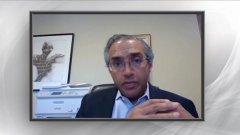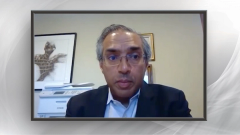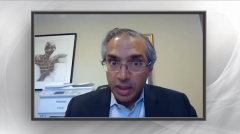
Treating OFF Episodes in Parkinson’s Disease During COVID-19
Episodes in this series

Experts wrap up their discussion of treating OFF episodes in Parkinson’s disease during COVID-19, including overcoming initial challenges with use of telemedicine, and offer advice for community neurologists treating OFF episodes.
Daniel E. Kremens, MD, JD: Very briefly, how has it been for you to initiate these new therapies during the pandemic? Patients are starting to get used to the world right now. We’re doing a lot of telemedicine where I am in Philadelphia. Patients were very reluctant to try new medications, afraid of switches, and they wanted to avoid the emergency department. In my area, as the virus has become more under control and as patients have become used to interacting via telemedicine, they’re much more comfortable. I’m having a lot more success initiating new therapies via telemedicine, even in the COVID-19 [coronavirus disease 2019] world. What’s your experience been?
Rajeev Kumar, MD: Yeah, it’s identical. I’m a little more fortunate being in Colorado. The number of cases we’ve had has been substantially less. At the peak, we had about 500 to 600 new cases per day in all of Colorado. Considerably lower incidence and prevalence compared with the Philadelphia, New Jersey, and New York areas.
Daniel E. Kremens, MD, JD: Yeah, we had 500 in our hospital.
Rajeev Kumar, MD: There you go. I don’t think we had more than 20 or 30 patients at a time and no more than 5 to 10 people vented at a time in the hospital where I’m located.
We’ve been comparatively spared from such severe outbreak. However, it has been scary—there’s no doubt—and tremendous fear from patients. We have implemented telemedicine where it’s been appropriate. I must say, for patients who are good historians and have good technical connection, telemedicine can be effective. However, for patients who have trouble connecting or have a lousy connection, who are not such good historians, or have more complex features on the examination and a better examination is necessary, telemedicine is, unfortunately, not a good substitute. We are seeing most patients in person, luckily, because we are in a little safer situation than you are.
If patients are farther away and have to travel, or if it’s known the patient is capable of doing a good job via telemedicine, then we’re often seeing telemedicine as an option. Currently, probably 20% of patients with Parkinson’s disease in my office are being seen by telemedicine. The majority are being seen in person. At the height, we were seeing probably 50% to 75% of patients who had Parkinson’s disease via telemedicine.
I would agree with you: There has been increasing acceptance of, “This is the new reality, let’s get on with things.” If you say, “We need to begin a new medication,” they’ll say, “Let’s begin it. Let’s go through it. Please email me, send me via the portal all the instructions on how to begin it, and I’ll be in touch with your nurses via the portal or phone you if I have any problems.” That’s been feasible.
Daniel E. Kremens, MD, JD: Yeah, I would say it was a real challenge at the beginning. Our health systems have adapted. They built more robust platforms. We’re learning ways around if there are difficulties using Zoom and things like that. Congress has been helpful. I’m really hoping this option remains for patients in the post–COVID-19 world. We’ve realized it’s not the same as an inpatient. It’s certainly a better way to see patients who have health or travel challenges. It’s a really exciting way. As technology gets better and patients become more educated, we’ll be able to continue this way of providing therapy.
To sum things up, what takeaway messages do you have for neurologists treating patients with Parkinson’s disease with respect to OFF episodes?
Rajeev Kumar, MD: Well, there’s good news. There are an increasing number of tools in terms of questionnaires and other means to identify OFF episodes, and we have a variety of ways of addressing them. Acutely, we can get the patient back ON with inhaled, subcutaneous, or sublingual therapy. We also have more options to keep patients ON—whether that’s via new oral medications like opicapone and istradefylline, new invasive therapies such as the upcoming apomorphine infusion pump, or well-established device-aided therapies such as Duopa [carbidopa-levodopa] and DBS [deep-brain stimulation].
We should not be accepting of disability, as I put it. When patients tell us, “We have OFF time,” I tell the patients, “It’s 1 of 3 things. Either I’m not doing a good job, you’re not helping me, or you have refractory disease. If you have refractory disease, we should be treating you aggressively to get you as good as we can, and we should have a discussion about expectations.” My expectation is we should be doing the best in assessing impact and improving quality of life. We can make a really big impact in helping our patients.
Daniel E. Kremens, MD, JD: I couldn’t agree with you more. That’s an excellent summary of the challenges we face with OFF episodes, including the fact that we shouldn’t be accepting of it. We have so many options now, and [we will have] more in the future. I’m hoping with using these options—rational polypharmacy and device-assisted therapies utilization—we can reduce the burden of OFF episodes for both our patients and their caregivers. OFF is something that affects everybody.
This has been extremely informative. Thank you, Dr Kumar, for this insightful discussion. Thank you to our audience for watching this NeurologyLive® presentation on the “Optimal Management of OFF Episodes in Parkinson’s Disease.” We hope you found this Peers & Perspectives® discussion to be useful and informative. Thank you very much.
Rajeev Kumar, MD: Thank you.
Newsletter
Keep your finger on the pulse of neurology—subscribe to NeurologyLive for expert interviews, new data, and breakthrough treatment updates.










































